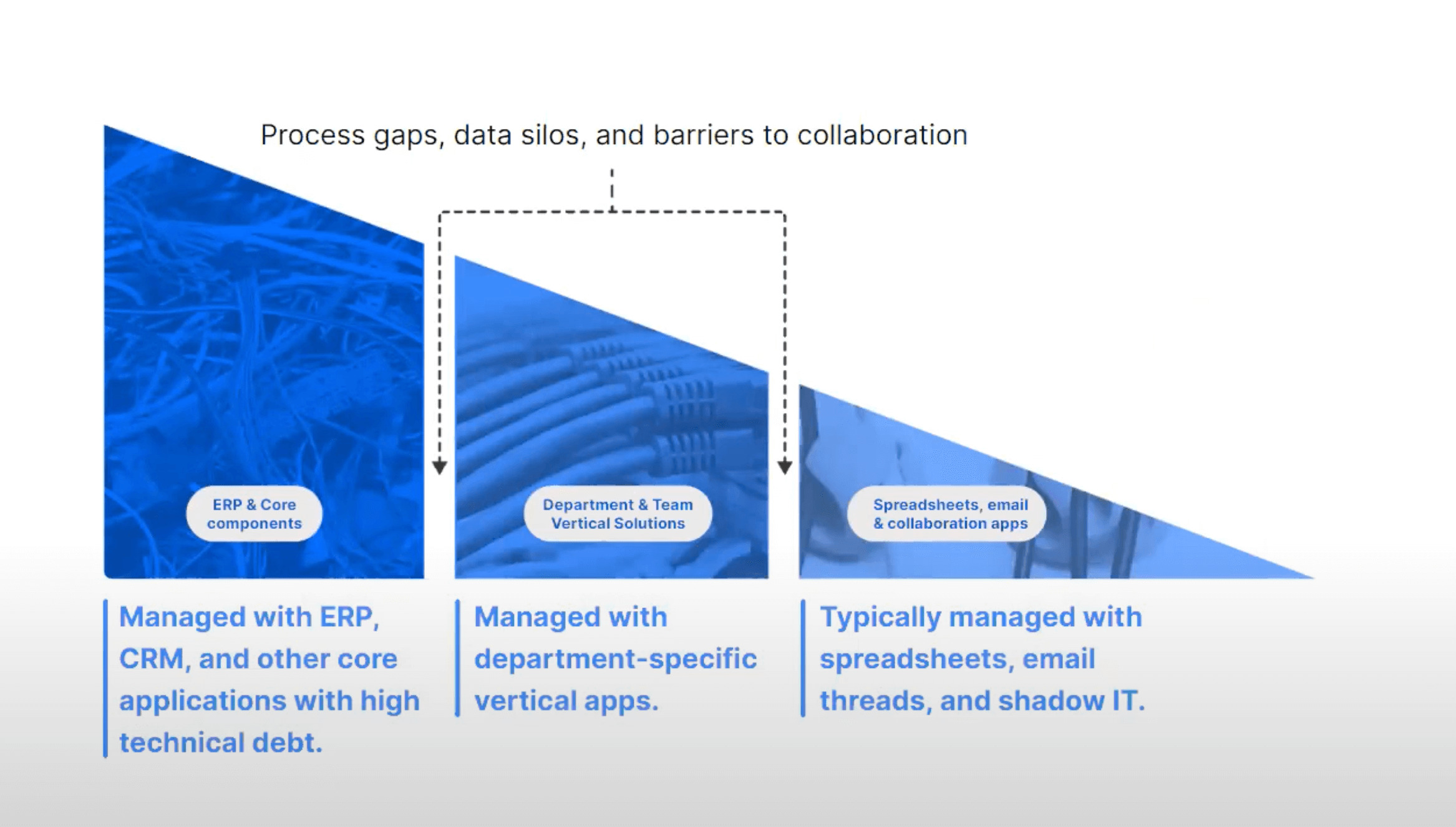
Digital change is a competitive differentiator for many companies, and it’s top of mind for executives today — especially as tech spending and usage increase as more businesses rely on technology to drive business growth.
But in order to continue this growth, businesses need to remain agile and pivot their business operations to adjust to the future of work and changing market dynamics.
In this webinar recap, Thomaz Coelho, Head of Customer Success at Pipefy, and Rafael de Castro, Partner Account Manager at Pipefy, share key insights into how companies are leveraging the benefits of low-code platforms to build and optimize agile processes.
Business agility and the benefits of low-code
Companies are looking for ways to get more value from existing systems. For teams looking to streamline workflows and processes without creating disruptions or more complexity, low-code software is proving to be the answer for more agile business processes.
“What we’re seeing is this need to invest in technology and invest in solutions is not a moment. All of those investments are here to stay,” says Coelho.
As a business solution, low-code workflow management software provides teams the autonomy they need to remain agile without compromising the security and oversight that IT requires to regulate and manage operations. In addition to this, low-code also:
Low-code advantage #1: Bridges the developer labor shortage gap
By 2024, Forrester estimates that the U.S. deficit of software developers will reach 500,000. Other sources cite that that deficit will reach 1.2 million by 2026 and a global 85.2 million by 2030.
“What we’re seeing is that for IT teams, the status quo of resolving all custom business process needs is not sustainable,” says Coelho.” “IT needs to keep prioritizing security, compliance, and governance, so to meet all those needs is an emerging new technology: low-code.”
Low-code solves this top challenge for IT decision-makers and makes digital transformation possible by providing business users with an IT-sanctioned set of tools. This not only takes some of the pressure off IT teams but also empowers teams to build applications that meet their needs quickly and with key insights to help improve the overall performance of business processes — all without adding to the IT backlog.
Low-code advantage #2: Aligns IT teams with business priorities
Low-code promotes continuous collaboration by breaking down the silos that traditionally keep business units and IT from developing effective and efficient business solutions.
Business units need agility. IT needs control. See how no-code delivers both with No-Code Automation: Good for Business, Great for IT
How low-code builds a system of engagement
To illustrate how low-code bridges the gaps between existing tech stacks, let’s dive into the recruitment process before and after low-code.
Before low-code: process gaps and data silos

“To the right side of this triangle, here we have the email communication or the spreadsheets that you are managing candidates and communication with,” says Castro. “In the center of the triangle, we have the vertical systems. This might be Workday or it might be another vertical system that you control the payroll with for those candidates. To the left side of the triangle, there is an ERP. It can be Oracle, SAP, or your ERP where you will register the salary and you will make sure that it’s the correct cost center and you can report this for your stakeholders.”
Without a low-code solution, there are gaps between these three sections that create process gaps, data silos, and barriers to collaboration. “What we see that is happening right now is that businesses are using local technology to engage all of those processes,” says Castro.
This means that each step in being handled manually, and the existing tech stack, rather than working for the business, works against the business and creates complexity between core, support, and long-tail processes.
After low-code: A system of engagement
Low-code business process automation closes process gaps and delivers increasing optimization support as processes move further from core business processes. “Low-code technology allows you to create one single system of engagement,” says Castro.

10 reasons to consider low-code
Low-code technologies offer undeniable benefits,” says Coelho. “It’s enabling the business team to be more agile and also providing this developer middle ground for IT between custom build and outsourcing.” But the benefits don’t stop there. Here are 10 additional reasons to consider low-code.
1. Low-code software is low cost.
“Splitting responsibilities between the business teams and the IT teams involves less time to actually develop and implement solutions. Time is money in today’s environment, so — if we’re using a low-code technology — for sure we are seeing low cost involved with deploying those solutions,” says Coelho.
2. Faster time to value.
“Of course, we’ll have back and forth with the operation team or the team involved in building the workflows, but it’s much easier to actually deploy those solutions,” says Coelho. “Going live is much faster than we used to see before.”
3. Eases pressure on development teams.
The IT backlog can get really long, so low-code eases the pressure on those teams and splits responsibilities with business users to actually get those solutions live. With greater process ownership, dev teams feel less pressure, and business units are empowered to create more agile processes.
4. Reduces IT backlog.
“We are reducing the number of items in the IT backlog, and making sure that IT’s investing their time and energy on things that really can make a difference, like working on integrating systems and managing risk and complexity,” says Coelho.
5. Lower maintenance burden.
By empowering the business user with low-code, they can also be the ones to maintain the processes and implement improvements and automation. This minimized burden makes business agility possible.
6. Increases creativity and innovation.
“We are increasing creativity and innovation,” says Coelho. “When we sit down with our customers, a lot of those sessions have the innovation department involved, the IT team involved, and the operations and business teams involved as well. It’s good to have this diverse way of thinking to make sure that we are building the best process for a specific business problem, and getting all those perspectives is really, really good.”
7. Stack extensibility.
Extending the existing tech stack with a low-code solution, like process automation, is key to solving any type of challenge that a company may face.
8. Yields better (and more agile) processes.
“As we are getting all those departments together and getting the business team to actually get their hands dirty and build those solutions with help from IT teams, the outcome at the end is much better,” says Coelho.
9. Improves productivity.
By reducing the time to run those processes, collecting information, collaborating, and reporting are much easier. In the end, this makes for well-built processes that give time back to the business team to focus on additional, more strategic work.
10. Transforms ideas into reality.
“By empowering users and citizen developers, we’re making sure that as they face a new problem that must be addressed, they are empowered with the right tech solution and the right support from the IT team to bring those ideas and bring the solutions that they are discussing with their customers into reality,” says Coelho.
ICYMI: Low-code webinar series recaps and insights
Unable to attend previous webinars? Don’t miss out on industry-leading conversations and insights. Check out our previous low-code webinar series recaps to keep informed:
Low-Code Webinar Series Recap: Why Low-Code Is Key to Digital Transformation, featuring guest speaker Carlos Cima, Vice President of Technology at SoftBank Group International.
Low-Code Webinar Series Recap: How IBM and Pipefy Navigate the Digital Landscape With Low-Code Solutions, featuring guest speaker Guilherme Novaes, Ecosystem Director at IBM Brasil.
Low-Code Webinar Series Recap: How Accenture Made Low-Code the Backbone of Digital Transformation and Innovation, featuring guest speakers Fabiano Guastella, Digital Innovation Associate Director at Accenture, and Clarison Benteo, Digital Transformation Manager at Accenture.
Low-Code Webinar Series Recap: How Lacoste and Ocean Network Express Used Pipefy to Transform Digital Experiences, featuring guest speakers Vinicius Castro, Operations and Digital Projects Manager at Lacoste, and Sergio Marques, Business Process Senior Analyst at Ocean Network Express.
Low-Code Webinar Series Recap: Dawn of the Low-Code Digital Era, featuring guest speaker John Bratincevic, Senior Analyst at Forrester.
Low-Code Webinar Series Recap: Digital Change & How to Build a Secure Foundation for Automation.







